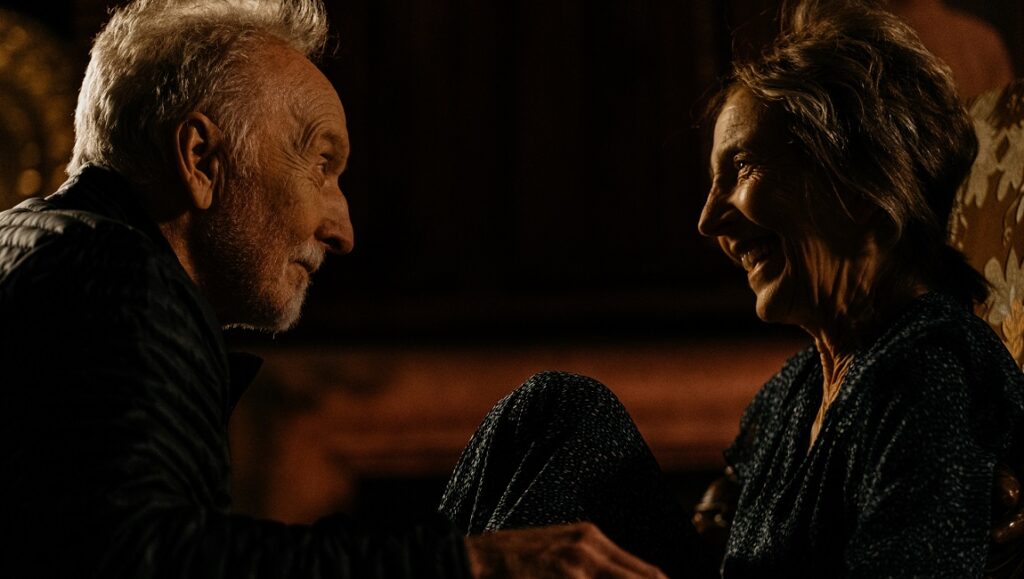The Call‘s throwback vibes don’t do much to add to its predictable style and lack of notable scares.
Arriving on the heels of the Fear Street films, The Call is another throwback teen horror, but apart from some fun outfits, it takes little inspiration or nostalgia from its ’80s setting which is seemingly only there to fit the current trend and justify the presence of the landline at its heart. Chester Rushing (Stranger Things) plays Chris, a new-in-town high school student who quickly finds an altogether typical teen movie trio to join: tough guy Zach, his comic relief lackey Bretty, and his charismatic yet mysterious ex-girlfriend, Tonya. After killing some time at the carnival, the four embark on a somewhat less savory timesink, harassing the town’s resident spooky elderly woman, Edith Cranston (Lin Shaye), referred to by the group as a witch and whom Tonya directly blames for the disappearance of her kid sister years ago. A sharp turn of events finds Edith dead and leaves the crew to face off with her husband Edward, played by none other than Saw’s Jigsaw killer Tobin Bell.
Like the reliable typecasting of Liam Neeson as a divorced dad with a certain set of skills, Bell further cements his own type here, a widower with lessons to teach, games to set in motion, and revenge to unfurl. This casting pays off big time, best evidenced by a chilling monologue that through sheer force of delivery elevates the proceedings far beyond their somewhat bargain bin appearance — visuals are muddy with oversaturated colors blending into the muck. In fact, the best scene of the film has us spending a wonderful albeit brief moment with the Cranstons, giving old pros Shaye and Bell (who, despite their limited presence, share top billing here) a chance to flex and instill the film with a surprisingly tender backbone. Trouble is, this spell can only last so long, and as soon as the Cranstons are out of the picture, any engagement and enthusiasm seeps away with them. (This isn’t so much the fault of the young cast, who each have moments, but are ultimately hamstrung by a plodding, by-the-numbers script.)
Getting to the meat of the matter, the central hook is a tantalizing one. In a menacing game presented by Edward Cranston to honor Edith’s final wish, the teens take turns entering a room and placing a call. If they can stay on the line for one minute, they win $100,000. The catch is that they’re calling a phone Edith was buried with, and while this lacks the life-or-death urgency of a Saw trap, something decidedly creepy is clearly going on. How sad, then, that this fun House on Haunted Hill-style premise is ruined by such uninspired follow-through. Once in the room with the phone, Director Timothy Woodward Jr. and screenwriter Patrick Stibbs reduce the film to a shoddy imitation of the recent It reboot, with Edith taking on the Pennywise role and subjecting the teens to their deepest seated fears and repressed memories. While this type of psychological torture is by no means unique to the It films, the influence here is obvious, from the strong focus on an abusive father figure, down to a reliance on sped-up body contortions that already felt over a decade stale when the Stephen King remake released in 2017.
However, even poor scares could likely be overlooked if there were sufficient character development leading up them — Andrés Muschietti’s It film at least made up for its ineffectual horror with a heartfelt core, something Woodward is desperately missing as we watch the two-dimensional archetypes ambiguously tormented with a lack of genuine investment. The rest is just a prosaic parade of hallucinations bleeding from their mouths and grimacing in the dingy yellow light, cracking shoulders as they scream into the frame. This assault subsides into a shrug of an ending and a twist you’ll see coming an hour before it hits, if only by virtue of there being so little plot to latch onto. For all of the frustrations with the state of brooding, arty horror today, films like The Call are a reminder of the wasteland of the aughts that preceded the trend, a deadened barrage of overbearing noise and image, neither particularly meaningful, scary, nor fun, just loud and jarring enough to shake you out of your seat.
You can stream Timothy Woodward Jr.’s The Call on Shudder beginning on July 15.


Comments are closed.